Industry Solutions
Internet Data Center Network Solution
The increase in the size of the data center directly leads to the leap-forward upgrade of the complexity of the network. Under the tide of new infrastructure, the demand for various types of digital infrastructure by enterprises and society continues unabated. For data and business to flow freely in the data center, an efficient network that can match the size of the data center is the key. The first step in building an efficient network is to choose the right network architecture.
Three data center scenarios, three networking models
With the deepening of digital transformation, "scene" once became a hot word in the past two years. While computing and storage devices are still racking their brains for the needs and designs of different scenarios, the scenario of the network has long been a consensus in the industry.
Just as people will build different levels of roads in the face of different traffic needs, engineers have already planned matching networking solutions according to the different sizes and applications of data centers.
Scenario 1: Small and Medium Data Center
The two-level Clos architecture is an earlier and more common network architecture for applications, and it is still the choice of customers in many industries. For small and medium-sized data centers that are generally limited in size, we can still form a reliable network with this simple structure with ever-increasing specifications of switches. This is the main reason why the two-level Clos architecture can be popular in small and medium-sized data centers.
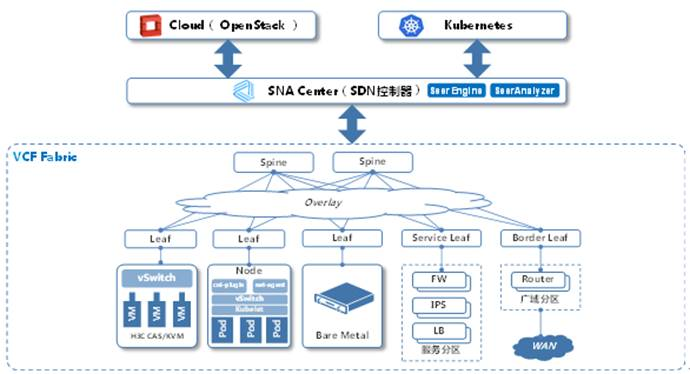
Typical two-level Clos architecture: H3C AD-DC application-driven data center solutions
In the two-level Clos architecture, the entire network device has only two roles. The advantages of this architecture are that the data forwarding path is short, the data forwarding path is reachable by one hop across Leaf, and the path and delay have strong consistency. The unified access mode also brings great convenience to online deployment and horizontal expansion, such as BGP protocol deployment, policy control, daily maintenance and troubleshooting.
In the two-level Clos architecture, the entire network device has only two roles. The advantages of this architecture are that the data forwarding path is short, the data forwarding path is reachable by one hop across Leaf, and the path and delay have strong consistency. The unified access mode also brings great convenience to online deployment and horizontal expansion, such as BGP protocol deployment, policy control, daily maintenance and troubleshooting.
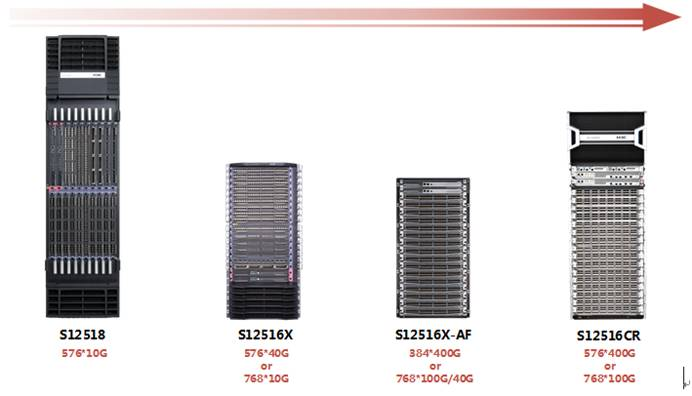
Typical two-level Clos architecture: H3C AD-DC application-driven data center solutions
The two-stage Clos architecture is more mature in adapting to the commercial SDN controller scheme. Combined with the SDN controller, the EVPN-based network Overlay scheme can be quickly constructed, which reduces the deployment difficulty of east-west and north-south service chains and meets the network's demand for linkage of VM, bare metal, containers and other full-form computing resources in cloud scenarios.
In addition, the architecture is also applicable to large enterprises in the deployment of convergence room and edge room, used to build edge computing network, ease the backbone network pressure and reduce access delay.
Scenario 2: Medium to large data center
The size of the servers supported by the two-level Clos architecture is generally less than 20000, and the three-level Clos rackThe introduction of the two-level Clos architecture solves the bottleneck of the network scale. The three-level Clos architecture adds a one-level aggregation switch (Pod Spine) in the middle of the two-level Clos architecture. A group of Pod Spine switches and all Leaf switches connected to it form a Pod, and multiple Pods are interconnected through Spine layer switches to form the entire network. You can increase the number of pods to achieve horizontal network expansion, greatly improving the network expansion capabilities. At the same time, the three-level Clos architecture is more flexible in terms of adapting to multiple business needs and providing differentiated services.
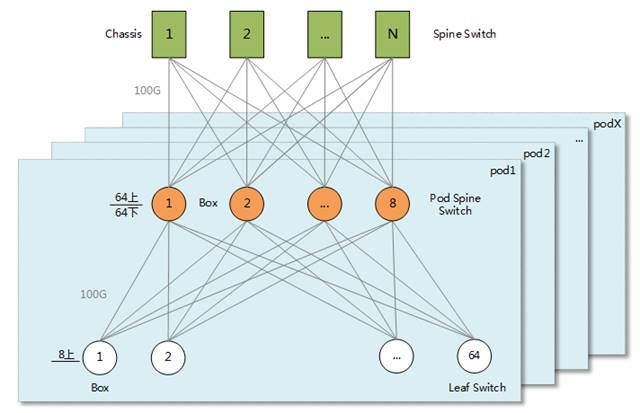
Three-level Clos architecture example
In addition, due to the introduction of high-density aggregation switch Pod Spine, the frame core switch at the Spine layer breaks through the single-digit limit and can deploy dozens of them. The total number of ports provided by the frame core switch at the Spine layer can be used to connect dozens of Pods, and the entire network can support more than 100000 servers.
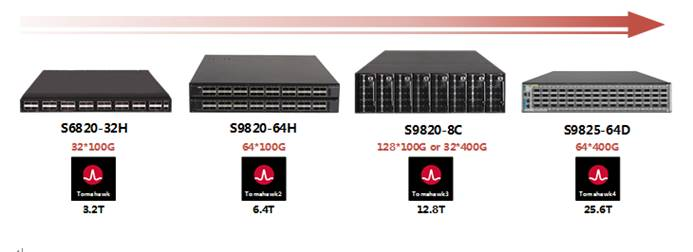
Performance Evolution of Xinhua Three High Density Convergence Switches from 32*100G to 64*400G
In addition, by adjusting the ratio of the uplink and downlink ports of the pod Spine switch in the pod, the convergence ratio of each pod can be flexibly defined, which helps reduce costs and avoid unnecessary waste while meeting different business requirements.
Scenario 3: Large and very large data centers
Internet companies can always refresh people's perception of the word "massive", whether it is at the business model level or at the infrastructure level. Hundreds of millions or even billions of businesses per minute put forward higher requirements for the scale of the data center, which also drives the evolution of the network structure again. The multi-plane networking architecture based on box devices is a new architecture adopted by the current head Internet companies to form large-scale and ultra-large-scale data center networks.
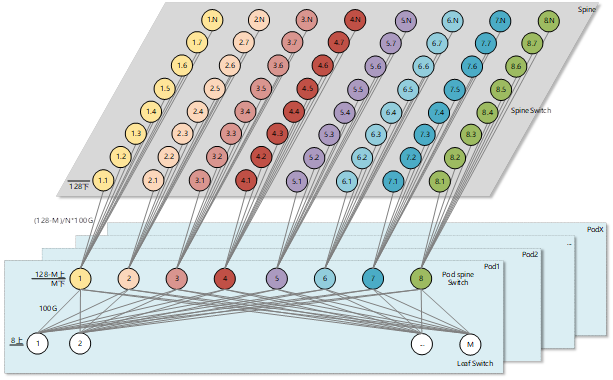
Example of Multi-Plane Networking Based on Box Device
Different from the three-level Clos architecture, each Pod Spine needs to be fully interconnected with all Spine layer switches. The Spine layer switches in the new architecture are divided into multiple groups (the number of groups is the same as the number of Pod Spine switches in each Pod). The Spine switches in each group can form an independent plane, while the Pod Spine switches in each Pod only need to be fully interconnected with the Spine switches in the corresponding plane.
In this way, the entire Spine layer can connect more Pods and build a very large-scale network supporting hundreds of thousands of level servers. Moreover, as the performance of the box switch increases, the architecture can continue to increase the capacity space.
At the same time, because Spine and Pod Spine use the same equipment, the entire network has a high degree of consistency in terms of functionality, forwarding delay, and so on. This creates a huge advantage for business deployment and network tuning. In addition, the entire network can maintain synchronization in the evolution from 100G networking to 200G, 400G networking and subsequent higher-speed networking.
Future Data Center Networks
01, Visual Network Management
From the above three data center networking solutions of different sizes, we can find that no matter what kind of architecture, management is a core issue that cannot be talked about. Then, the question ensues: how to achieve more efficient network management at a lower cost?
Seeing the traffic situation, we can better manage the highway; the visualization of the network is also the premise of efficient management.
In practical applications, network visualization technology can not only complete end-to-end traffic monitoring, risk warning, and assist in troubleshooting; it can also realize the optimization design of data center network architecture through data accumulation and analysis.
02, intelligent network card will become the new end of the network

The End-to-End Solution for SmartNIC UniServer Server of Xinhua 3 Switch
In the future, intelligent network cards will be an important part of DCN network. Intelligent network cards with programmable capability not only release CPU resources and realize high-performance forwarding, but also have tunnel encapsulation/decapsulation, virtual switching, encryption and decryption, RDMA and other functions. With the increase of business scenarios and requirements, more and more data plane functions will be completed by intelligent network cards, breaking the limitations based on servers or switches, promise the perfect balance of performance, functionality and flexibility.
In the digital age, network progress never stops
China has built nearly 5 million kilometers of various roads in 70 years, which directly promoted the social and economic take-off. Similarly, in the development of data centers, the pursuit of efficient networks is endless. As a leader in digital solutions, the New H3C Group, a subsidiary of Ziguang, which has emerged in the network field, also has a deep insight into the relationship between business value, data center and network. Efficient data center networks connect the entire chain from data to business to value in the digital age.
Previous Page
Next Page
Previous Page
Next Page

